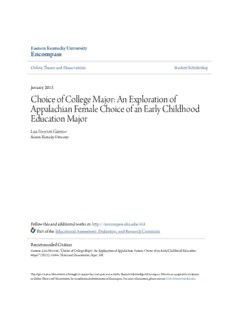
Choice of College Major PDF
Preview Choice of College Major
Eastern Kentucky University Encompass Online Theses and Dissertations Student Scholarship January 2013 Choice of College Major: An Exploration of Appalachian Female Choice of an Early Childhood Education Major Lisa Newton Gannoe Eastern Kentucky University Follow this and additional works at:https://encompass.eku.edu/etd Part of theEducational Assessment, Evaluation, and Research Commons Recommended Citation Gannoe, Lisa Newton, "Choice of College Major: An Exploration of Appalachian Female Choice of an Early Childhood Education Major" (2013).Online Theses and Dissertations. 168. https://encompass.eku.edu/etd/168 This Open Access Dissertation is brought to you for free and open access by the Student Scholarship at Encompass. It has been accepted for inclusion in Online Theses and Dissertations by an authorized administrator of Encompass. For more information, please [email protected]. Choice of College Major: An Exploration of Appalachian Female Choice of an Early Childhood Education Major By Lisa N. Gannoe Master of Education Eastern Kentucky University Richmond, Kentucky 2002 Bachelor of Science University of Kentucky Lexington, Kentucky 1992 Submitted to the Faculty of the Graduate School of Eastern Kentucky University in partial fulfillment of the requirements for the degree of Doctor of Education August, 2013 i Copyright © Lisa Newton Gannoe, 2013 All Rights Reserved ii DEDICATION This thesis is dedicated to my husband, Paul, for his unwavering support. iii ACKNOWLEDGMENTS I would like to thank my Chair, Dr. Charles Hausman, for his guidance, support and patience. I would also like to thank the other committee members, Dr. James Bliss and Dr. Deborah West, and Dr. Carol Patrick for their comments, flexibility, and assistance. Without the continual love and support of my parents and spouse, I would not be at this point in my life. Finally, I thank Teresa New for her dedication in transcribing many hours of audio files. iv ABSTRACT First generation Appalachian female students are exposed to gender differences in roles and career choices that are modeled in the family. A case study approach was used to obtain qualitative data from five students at Eastern Kentucky University and their mothers regarding why these students chose to major in child development and early childhood education. Bandura’s Social Cognitive Learning Theory and Bronfenbrenner’s Ecological Systems Theory were used as frameworks for the study. The findings of the study are valuable in advising college students’ on selection of a college major and recruitment of dedicated child development and early childhood education professionals through understanding the influences and motivations of the five students and their mothers. v TABLE OF CONTENTS CHAPTER PAGE I. INTRODUCTION ...................................................................................................1 The Problem .............................................................................................................5 Purpose of the Study ................................................................................................6 Significance of the Study .........................................................................................8 Research Method .....................................................................................................9 Definition of Key Terms ........................................................................................10 II. LITERATURE REVIEW ......................................................................................12 Appalachian and Rural Students ...........................................................................13 First Generation College Students .........................................................................14 Gender Role Views ................................................................................................16 Women’s Self- Efficacy .........................................................................................18 Role Models ...........................................................................................................20 Family Influences and Effect on Choices ..............................................................22 Summary of Literature ...........................................................................................25 III. METHODS ............................................................................................................28 Research Approach ................................................................................................28 Research Questions ................................................................................................29 Interview Questions ...............................................................................................29 Research Sample ....................................................................................................30 Data Collection ......................................................................................................33 Data Collection Tools ............................................................................................35 Interviews ...................................................................................................35 Observations ..............................................................................................35 Memo-Writing ...........................................................................................36 Data Analyses ........................................................................................................36 Trustworthiness of the Data ...................................................................................38 Value to the University and Participants ...............................................................39 Limitations .............................................................................................................40 Summary ................................................................................................................40 vi IV. FINDINGS .............................................................................................................41 Appalachian and Rural Communities ....................................................................42 Family Definition and Ideas...................................................................................44 Qualities of Mother and Grandmother ...................................................................45 Qualities of Father and Grandfather ......................................................................47 Division of Labor ...................................................................................................48 Mother at Home vs. Employment ..........................................................................49 Self -Efficacy .........................................................................................................50 Child Development ................................................................................................53 Family Attitude Toward Major ..............................................................................55 Changes In Attitude Toward Family and College .................................................57 Role of Women ......................................................................................................60 Benefits and Barriers to a Major in Child Development and Early Childhood Education ...............................................................................................................62 Role Models and Influences...................................................................................65 Attitudes Toward School .......................................................................................67 Parental Message about Education ........................................................................69 Information about College .....................................................................................71 Alternative Majors and Attitudes of Subjects ........................................................74 Community, State, and Federal Government and Early Childhood Education .....76 Child Care Programs vs. Keeping Children at Home ............................................79 Eastern Kentucky University .................................................................................81 Future Plans ...........................................................................................................82 Staying in Home Community ................................................................................83 Generational Changes ............................................................................................85 Life Satisfaction .....................................................................................................85 Eco-Map .................................................................................................................87 V. DISCUSSION .......................................................................................................90 Daughters Influence on Mothers ............................................................................90 Influence of Employer and Co-Workers ................................................................92 Future Plans of Students’ Children ........................................................................93 Reasons for Selecting an Early Childhood Education Major ................................95 The Influence of Mothers on Education Choices ..................................................97 The College Major Decision-Making Process .......................................................99 Satisficing and Bounded Rationality .........................................................99 Need Theory.............................................................................................100 Social Cognitive Learning Theory ...........................................................101 Bronfenbrenner’s Ecological Systems Theory ........................................102 Implications for Policy and Future Research .......................................................102 Concluding Thoughts ...........................................................................................105 REFERENCES ...............................................................................................................106 vii
Description: